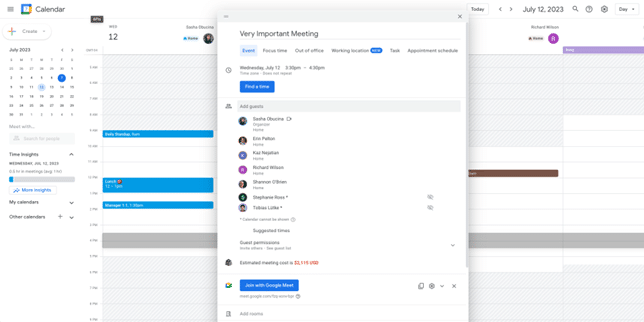The News: As a part of its ongoing effort to maximize time for building, this week, Shopify released an internal plugin for its calendaring tool that calculates the cost of a meeting during the scheduling process. The tool is intended to empower employees to make more active and informed decisions when deciding the best way to communicate internally. The initial Bloomberg report on the announcement can be found here.
Shopify Empowers Employees with Plugin that Exposes the Cost of Meetings
Analyst Take: Shopify has tackled the problem of wasted time in meetings head-on. In the last year, the company has announced a ban on recurring meetings with more than 2 people, heavily discouraged meetings on Wednesdays, and limited meetings of more than 50 people to a 6-hour window on Thursdays.
The latest enhancement, a plugin for Google Calendar, exposes the cost of a meeting during the scheduling process and is intended to jolt employees out of the autonomic behavior of scheduling a meeting to resolve an issue and inviting everyone who might possibly have any input or response to the content.

The tool estimates the cost of a meeting based on average salaries for the roles of all invitees and the meeting length in a simple but effective calculation of the dollar value of the meeting. Typical meetings can cost from $700 to $1,600, but those costs will swell as the number of employees invited, length of meeting, or level of employees increases.
The problem of wasted time in meetings is well understood, and helping employees make more active, informed decisions when booking meetings is a great way to put downward pressure on the number and scale of meetings in the enterprise today. However, there is a balance to be struck between the needs of employees to feel engaged and informed and the needs of employees and companies to get the work done.
Remote and hybrid work is stretching the social fabric of organizations in new and interesting ways. Employees feel less engaged, and enterprises are paying the price in the form of reduced employee retention, increased absenteeism, unsettled productivity metrics, and lower profitability. Shopify itself went fully remote during the pandemic. In a 2020 blog post about the new remote working model, a Shopify employee is quoted saying, “Your internet speed isn’t the only connection that’s crucial for remote work—human connections are also critical,” and he is dead right.
It is hard to say that there is a lot of human connection happening in large meetings. However, a recurring meeting among a small group can be an incredibly healthy component in maintaining engagement and connection among coworkers. However, seeing that our Friday virtual happy hour or a simple chat among team members is costing us hundreds or thousands of dollars creates a disincentive to put some time on the calendar to catch up.
The intent here is good, clearly. But organizations should make sure that meetings are not the enemy. They are a tool that gets misused a lot. And like a child banging a screw into a board, the situation requires education and coaching rather than the eradication of all hammers. The simple act of booking time in a calendar to speak with a person or group of people is not an inherently evil act. It has a lot of positive outcomes. A balance must be struck.
When employees are made to feel the financial impact of any and all scheduled human interactions, what happens to the balance? Does a phone call cost less because people can multitask and pay less attention? Is it better to have a meeting with 10 people or send them a long email they will never read? As we reduce the number of meetings, are we creating countervailing forces to push other, ostensibly better, methods of communication upward or just letting the need to communicate and collaborate fall through the cracks? We will know more in time, but we should tread lightly when disposing of longstanding modes of communication. Even ones that we misuse like meetings. They got us here.
Disclosure: The Futurum Group is a research and advisory firm that engages or has engaged in research, analysis, and advisory services with many technology companies, including those mentioned in this article. The author does not hold any equity positions with any company mentioned in this article.
Analysis and opinions expressed herein are specific to the analyst individually and data and other information that might have been provided for validation, not those of The Futurum Group as a whole.
Other insights from The Futurum Group:
Zoom Adds Generative AI-Powered Zoom IQ Features. Will They Resonate?
Author Information
Sean is a Senior Analyst strategically focused on cloud-based collaboration and its impact on worker productivity and human connection. Sean provides research on market sizing and forecasts, product and service evaluations, and end user/buyer insight.
Sean is a trusted advisor to and assists industry vendors and enterprises with workplace communications and collaboration strategies, market entry and product assessment, product portfolio analysis, and sales enablement services.
Prior to Wainhouse, now a part of The Futurum Group, Sean was the Chief Product Officer at PGI, owning the product strategy and roadmap for a full suite of B2B and B2B2C SaaS communications products including an enterprise grade phone system, audio meetings, video meetings, messaging, video webinars, high touch attended audio conferences and massively scaled video webcasts.
Sean holds a Bachelor of Science in International Business from University of Colorado, Boulder.





